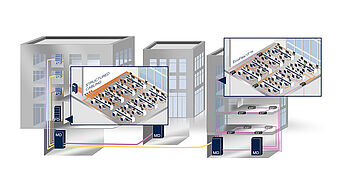LAN solution from the cabling specialist eliminates heat problems with PoE through innovative network architecture
Augsburg, June 23, 2020 – Rosenberger Optical Solutions & Infrastructure (Rosenberger OSI), manufacturer of innovative fiber optic cabling infrastructures in Europe, announces that its in-house solution for building cabling is optimized for Power over Ethernet (PoE). The innovative PerCONNECT® EcoFlex‘ITTM network architecture shifts the focus of the cabling media towards future-oriented fiber optic technology and reduces the tertiary copper cabling to the terminal devices to a minimum. "The great advantage here is that no problems arise from cable heating due to a maximum length of the copper cables of 25 meters in PoE applications," says Stefan Wiener, Product Manager LAN at Rosenberger OSI.
PoE: Trend in building cabling
The use of PoE has been a major trend in LAN cabling of buildings for many years and has become an important component in this area. The technology enables the electrical power supply of network-compatible devices via an existing twisted-pair Ethernet cable. This means that in this case the data cable not only transmits the data signals but also the electrical power for terminal devices. The big advantage is that this eliminates the need for a separate power connection, thus reducing installation costs. Furthermore, PoE also proves to be beneficial when expanding networks. In buildings where it would be too expensive or too complex to lay new power lines, a network device can be installed much faster and more cost-efficiently.
Innovative network architecture minimizes power loss
The market requirements for PoE are increasing rapidly. The standard IEEE 802.3bt now allows a power output of 70 up to 100 watts. This is sufficient for the power supply of larger end devices such as a monitor or video cameras. At such a power level, however, PoE technology faces a major challenge: PoE generates power loss through the cable's line resistance and heat is generated. The higher cable temperatures in turn impair the transmission of data signals. To avert this problem, a cable temperature of 60°C must not be exceeded. One solution is to use cables with a larger copper core cross-section. For example, AWG22 cables are often recommended by the industry for installation. The major disadvantage here is higher purchase costs. "It is precisely at this point that the forward-looking concept of reduced lengths of the tertiary installation cables of PerCONNECT® EcoFlex‘ITTM becomes clear," emphasizes Wiener. Since with PerCONNECT® EcoFlex‘ITTM the copper cabling is reduced to a minimum and a length of 25 meters is not exceeded, the problem of cable heating is eliminated from the outset due to the short transmission distances and the power loss occurring with PoE is significantly reduced.



